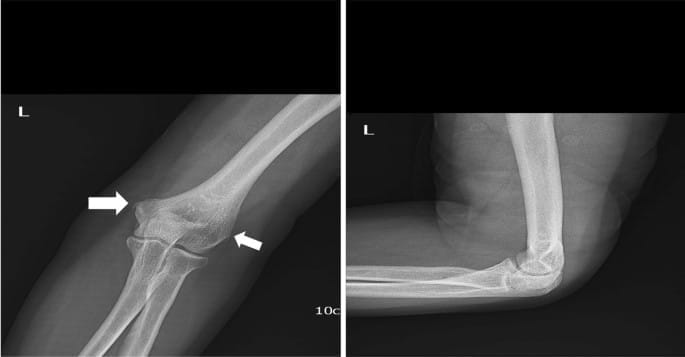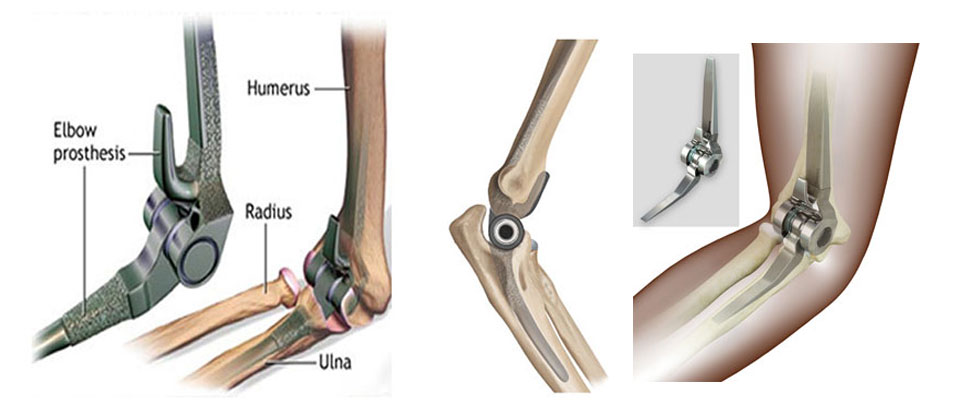What is Elbow Replacement?
Elbow replacement surgery involves replacing damaged parts of the elbow joint with artificial components. This surgery is typically considered for older adults who have severe elbow fractures that cannot be repaired with other methods.
Why Consider Elbow Replacement?
Most severe elbow fractures involve not just broken bones but also significant soft tissue damage. The primary goal is usually to repair the bone and soft tissues (open reduction and internal fixation, or ORIF). However, for older patients with low functional demands, elbow replacement might be a better option if ORIF is unlikely to provide a good outcome.
Understanding Elbow Anatomy
- Bones: Distal humerus (upper arm), proximal ulna, and proximal radius (forearm bones).
- Soft Tissues: Ligaments and muscles that provide stability and movement. Key muscles include the brachialis, common flexor, common extensor, and triceps.
- Nerves: The ulnar nerve is particularly important and runs near the elbow.
Causes of Elbow Fractures
Elbow fractures often result from direct impacts, such as falling and landing on the elbow. These injuries are more common and severe in older adults with weaker bones (osteoporosis).
Symptoms of Elbow Fractures
- Pain and swelling in the elbow.
- Difficulty moving the elbow, especially bending and extending.
- Bruising around the elbow.
- Possible nerve involvement, causing numbness or tingling.
Diagnosis
To diagnose an elbow fracture, doctors use:
- Physical Examination: Checking the entire arm for additional injuries and assessing the extent of damage.
- X-rays: Standard imaging to see the bone structure and identify fractures.
- CT Scans: For more detailed images, especially useful in complex fractures.
Non-Surgical Treatment
In some cases, non-surgical treatment may be used, especially for elderly patients with low physical demands:
- “Bag-of-Bones” Technique: Allowing the broken pieces to heal naturally with minimal intervention.
- Rehabilitation: Using a collar and cuff support to allow movement.
Surgical Treatment
Open Reduction and Internal Fixation (ORIF)
This procedure involves:
- Aligning the bones and securing them with plates and screws.
- Primary goal: Achieving stable bone healing and allowing early movement.
- Best results: Typically seen in younger patients with stronger bones.
Elbow Replacement
When ORIF is not viable, elbow replacement may be considered:
- Total Elbow Arthroplasty: Replacing the entire elbow joint with an artificial one.
- Advantages: Provides pain relief and improves function.
- Disadvantages: Limited to older adults with low activity levels.
- Distal Humerus Hemiarthroplasty: Replacing part of the elbow joint while preserving some natural bone.
Pearls and Pitfalls
Indications
- A complete history and physical examination should be performed, including questions about bone density and healing tendency.
- Address associated injuries at the elbow, wrist, and shoulder.
Planning
- Consider fracture repair (osteosynthesis) when the patient has good bone quality and high functional demands.
- Have arthroplasty (joint replacement) available for older patients with low demands, with a plan to switch to this if osteosynthesis is not possible during surgery.
Exposure
- Initial protection and careful dissection of the ulnar nerve are crucial.
- If removing the triceps from its attachment (Bryan-Morrey approach), mark and reattach it anatomically.
- During a triceps-sparing approach, preserve the tendon attachment to the olecranon.
Inspection
- Thoroughly inspect the ulna and radial articular surface to consider hemiarthroplasty in younger patients.
- Observe the state of the ulnar nerve and surrounding muscles.
Bone Preparation
- Preserve intact humeral columns and their muscle attachments during total elbow replacement.
Implantation
- Ensure proper tension of the brachialis and triceps muscles.
- Use an appropriate implant for hemiarthroplasty, especially for younger, active patients.
- Avoid over- or under-sizing the joint and check with fluoroscopy after trial implantation.
Wound Closure
- Use drains as needed, and ensure proper hemostasis. Apply a moderately tight bandage for the first 12 hours to avoid hematoma formation.
Postoperative Care
- Use a splint to keep the elbow in full extension for the first 24-48 hours.
- Elevate the arm to prevent swelling.
- Avoid nonsteroidal anti-inflammatories as they can hinder healing.
- Start gentle active and passive movements after the second day post-surgery.
- Use a molded splint at 90 degrees flexion to protect the triceps repair.
- Gradually increase motion, aiming for more than 90 degrees of flexion after 5 weeks.
- Follow specific rehabilitation protocols to ensure proper healing and function.
Outcomes
Total Elbow Arthroplasty
- Studies have shown good to excellent results in older patients with comminuted distal humeral fractures.
- Patients generally achieve significant pain relief and functional improvement.
Distal Humeral Hemiarthroplasty
- Suitable for younger, active patients with complex fractures.
- Good outcomes have been reported, but the procedure is technically demanding and not widely performed.
Conclusion
Elbow replacement is a reliable option for severe, unreconstructable elbow fractures in older adults, providing pain relief and improved function. For younger, more active patients, distal humeral hemiarthroplasty may be considered, although it requires careful planning and execution. Always follow your doctor’s advice and attend follow-up appointments to ensure the best recovery outcome.






